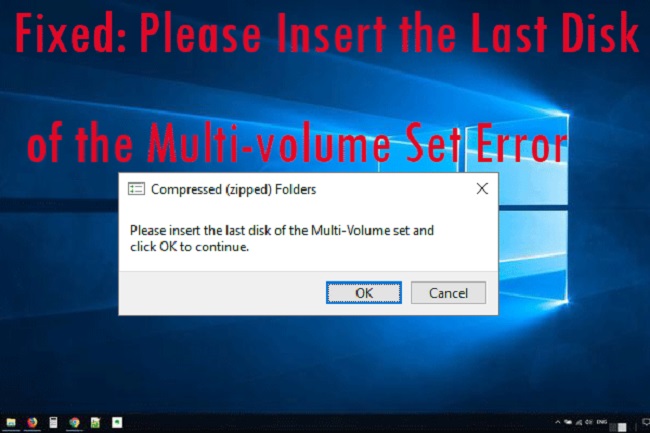The error only briefly returns after clicking the OK button, according to the affected users. Investigation of the problem reveals that the corrupted.zip folder in the root directory of one of the drives that is currently in use on your computer is what the error message is indicating.
On drives that have previously been inserted into a Mac system, this is a common occurrence. This occurs as a result of the Mac OSX creating numerous hidden files on drives with the FAT32 file system that Windows incorrectly interprets as corrupted.

These files, which are used to store indexing information and icon data for the Finder application, are actually not damaged or harmful. The operating system interprets the folder as corrupted because of the.zip extension.
The Compressed (zipped) Folders error, however, can also be brought on by a USB Controller bug or a genuine, incomplete.zip file. The “Please insert the last disc of the multi-volume set and click OK to continue” error will occur without apparent cause because File Explorer’s indexing function tries to index compressed files.
The following techniques might be useful if you’re having trouble with the Compressed (zipped) Folders error right now. Here is a list of solutions that users in similar circumstances have used to fix the problem. Please work through each of the suggestions below in turn until you find one that makes your problem go away.
Every time a user tries to open a Windows Explorer window, they receive the annoying message, “Please insert the last disc of the multi-volume set and click OK to continue.” This problem, also known as the Compressed (zipped) Folders error, This problem is not unique to Windows 10; reports of it are also frequently made for Windows 8 and Windows 7.
Contents
Method 1. Eliminating the Drive’s Hidden Folder(s)
Finding and deleting the problematic.zip folder is one solution that has been used by many users to fix the Compressed (zipped) Folders error. You must first enable Hidden items because this folder (or folders) will typically be hidden.
The steps to find and delete the files responsible for the Compressed (zipped) Folders error are given below:
- Launch File Explorer, then select the View tab (in the top ribbon). After that, make sure the Hidden items checkbox is selected.
- Open up each drive and scan for any semi-translucent files that end in “.zip” while hidden items are enabled. If any, right-click on them and select Delete to get rid of them from the drive.
- Continue step 2 with each drive that appears in File Explorer until you are certain that there are no hidden folders left that could still be the source of the problem.
- Restart your computer, and after it starts up, check to see if the Compressed (zipped) Folders error appears when you launch File Explorer.
Go down to Method 2 if you’re still having trouble.
Method 2. Reset the External Drive or Delete it
You can fix the Compressed (zipped) Folders error by formatting the drive if you were unable to identify the problematic file but you only notice this problem when an external flash drive (or SD card) is inserted.
Just make sure to save any files you don’t want to lose before choosing Format from the right-click menu when you right-click on the problematic flash drive. Next, select Quick Format by checking the box next to Preserve the Default File System Format. By formatting the flash drive after pressing Start, the computer will fix the Compressed (zipped) Folders error.
Disconnecting the flash drive from your computer is another way to resolve the “Please insert the last disc of the multi-volume set and click OK to continue” error without addressing the underlying problem.
Move on to the alternative strategy if the first one failed.
Method 3. Installing USB Controllers Again
The USB Controllers drivers have been updated by some users to solve this problem. All of this is done through Device Manager, but if the first approach doesn’t work, you might have to uninstall the Host Controller and let WU (Windows Update) reinstall the drivers.
For quick instructions on reinstalling the USB Controllers, see below:
- To bring up the Run box, press Windows key + R. Then, enter “devmgmt.msc” to launch Device Manager.
- Right-click the Host Controller by expanding the Universal Serial Bus controller, then choose Update Driver.
- Select Search automatically for updated driver software on the following screen, then wait for the procedure to finish.
- Restart your computer after WU has finished installing the new driver version to check if the Compressed (zipped) Folders error has been fixed.
Conclusion
If WU discovers that you already have the most recent version of the USB Host Controller, choose Uninstall driver from the context menu by right-clicking. Restart your computer after that so that WU can reinstall the drivers when it starts up.
If none of the aforementioned solutions have worked for you at all, backup your files in your driver. Format the USB Driver after that. See if that fixes the problem for you.

![WLDCore.dll is Missing Error in Windows 10 [RESOLVED] WLDCore.dll is Missing Error](https://howandwow.info/wp-content/uploads/2019/09/WLDCore.dll-is-Missing-Error.jpg)




![Err_Connection_Reset Error in Chrome [RESOLVED] Fix Err_Connection_Reset Error in Google Chrome](https://howandwow.info/wp-content/uploads/2019/09/Fix-Err_Connection_Reset-Error-in-Google-Chrome.jpg)
![DNS_Probe_Finished_No_Internet Error [RESOLVED] Fix DNS_Probe_Finished_No_Internet Error](https://howandwow.info/wp-content/uploads/2019/09/Fix-DNS_Probe_Finished_No_Internet-Error.jpg)

![Err_Cache_Miss in Google Chrome Error [RESOLVED] Err_Cache_Miss in Google Chrome Error](https://howandwow.info/wp-content/uploads/2019/08/How-to-Fix-Confirm-Form-Resubmission-Error.jpg)






![Steam Missing File Privileges Error [RESOLVED] How to Fix Steam Missing File Privileges](https://howandwow.info/wp-content/uploads/2020/07/How-to-Fix-Steam-Missing-File-Privileges-Error-100x70.jpg)




![SIM Not Provisioned MM#2 Error [RESOLVED] SIM Not Provisioned MM#2](https://howandwow.info/wp-content/uploads/2020/03/SIM-Not-Provisioned-MM2.jpg)






